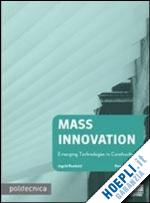Today, for several reasons technology in construction seems to be called to a rethink. This is due to different reasons, internal and external to the sector, that are developing new challenges for designers and producers pushing them to find innovative solutions for this changing scenario. This framework helps to account for a 'Mass Innovation', made of incremental changes brought about by the development and introduction of digital control systems in buildings, or information and communication systems within construction processes, other new social meanings and requirements, generally of new awareness of human being on the potentialities of knowledge, of its sharing and its broad diffusion.Through the text emerging technologies for innovation are identified: Customized Industrial Construction, underlying the idea to go from product choice versus design system. Digital Fabrication, an emerging way of approaching technology and fabrication. than fast and incredible changes due to Cloud and Information Technologies for architecture and construction, Materials on Demand due to chemical advancement, and Widespread Technology Transfer, just to mention some of them. Finally a glance is given to new trends like self design and mini factories, on site robotics and augmented reality and inventive preservation. This book is innovative in its contents and structure, giving an olistic and awarned perspective, that is contemporary and really expressive of our times. Ingrid Paoletti, Assistant Professor of Building Technology at the Building Environment Science Technology Department (BEST) at Politecnico di Milano University. She is a member of the Cluster on 'Innovative Technologies and Construction Industry' and she is CIB member, Task Group 119 on Customized Industrial Construction.The research activity is characterized by a constant interest in deepening the role of technical innovation in architecture with a particular emphasis on innovative envelopes and advanced construction methods.She has written several books and articles including Building Complex Shapes ( Libreria Clup, 2008), Innovative Design and Construction Technologies (Maggioli, 2009) Future Systems (Franco Angeli, 2010). Paola Tardini, architect, collaborates with the research activity at the Building Environment Science Technology Department (BEST) at Politecnico di Milano University.She researches on themes like the role of technological innovation in contemporary architectural practice and collaborates on the teaching activities of Politecnico.She is junior architect at Infrastructures & Constructions Department of Expo 2015 S.p.A. as part of the team that develops the Expo project.











